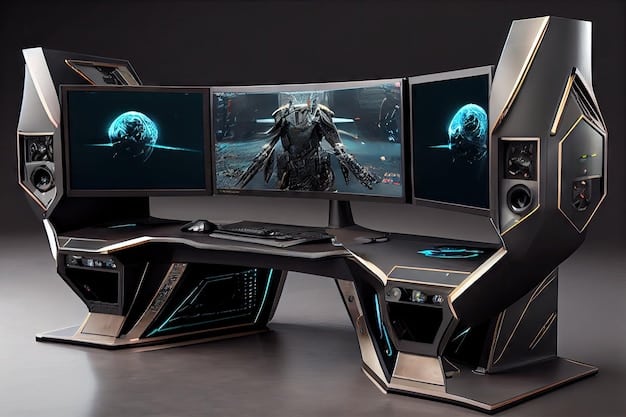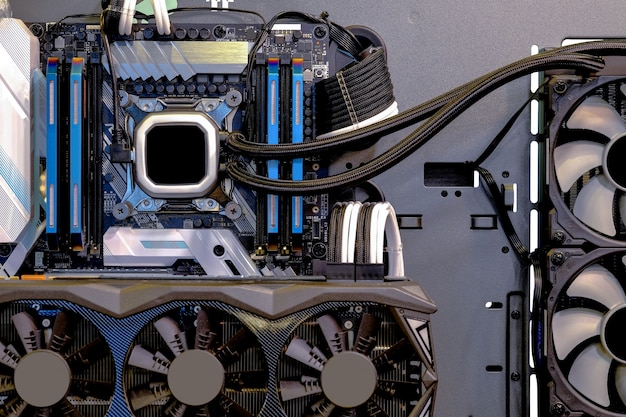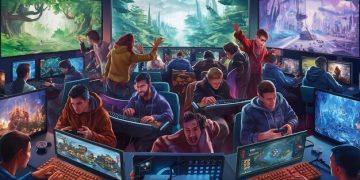The Future of PC Gaming: Ray Tracing, DLSS, and Tech in 2025

The Future of PC Gaming: Ray Tracing, DLSS, and Other Cutting-Edge Technologies in 2025 promises to deliver unprecedented levels of visual fidelity, performance enhancements, and immersive experiences, driven by advancements in hardware and software, transforming the gaming landscape.
The gaming world is constantly evolving, and looking ahead to 2025, the Future of PC Gaming: Ray Tracing, DLSS, and Other Cutting-Edge Technologies in 2025 seem poised to redefine the gaming experience. Imagine a world where every game is incredibly realistic, runs smoothly, and immerses you like never before. Let’s explore what this future might hold.
Ray Tracing: A New Era of Realism
Ray tracing is a rendering technique that simulates the way light behaves in the real world. By tracing the path of light rays and simulating their interactions with objects in a scene, ray tracing can produce incredibly realistic reflections, shadows, and lighting effects. This technology is set to become even more prevalent in 2025.
The Impact of Ray Tracing on Visual Fidelity
Ray tracing elevates visual fidelity to new heights, making virtual worlds feel more realistic than ever before. The subtle nuances of light and shadow, the way reflections dance across surfaces, and the overall depth of the scene contribute to a more believable and immersive experience.
Challenges and Solutions for Ray Tracing
While ray tracing offers stunning visuals, it can be computationally intensive. To address this, developers are optimizing ray tracing algorithms and leveraging hardware acceleration technologies to make it more accessible without sacrificing performance. This balance ensures that gamers can enjoy enhanced visuals without compromising on frame rates.

- Improved realism in reflections and shadows.
- Enhanced lighting effects for a more immersive experience.
- Optimization for better performance on various hardware configurations.
In conclusion, ray tracing is at the forefront of visual advancements in PC gaming, promising to deliver unparalleled realism and immersion. As hardware and software continue to evolve, ray tracing will become an integral part of the gaming experience, setting new standards for visual quality.
DLSS: Boosting Performance Without Sacrificing Visuals
Deep Learning Super Sampling (DLSS) is an AI-powered technology that boosts performance in games without sacrificing visual quality. By using deep learning algorithms to upscale lower-resolution images, DLSS can deliver higher frame rates and smoother gameplay, even on demanding titles. This is crucial for enjoying the benefits of ray tracing and other advanced effects.
How DLSS Works: An AI-Powered Solution
DLSS uses a deep neural network trained on high-resolution images to intelligently upscale lower-resolution frames. This results in visuals that are nearly indistinguishable from native high-resolution rendering, but with significantly improved performance. The AI learns to reconstruct intricate details, preserving fidelity while reducing the computational load.
The Evolution of DLSS: From Initial Skepticism to Wide Adoption
Initially, DLSS faced skepticism due to concerns about image quality. However, with each iteration, DLSS has improved significantly, addressing these concerns and earning widespread adoption among gamers and developers. Today, DLSS is recognized as a crucial technology for maximizing performance in graphically intensive games.
- AI-powered upscaling for enhanced performance.
- Minimal visual quality loss compared to native rendering.
- Continuous improvements and wider game support.
In summary, DLSS is a game-changing technology that enables smoother gameplay and higher frame rates without compromising visual quality. Its continued evolution and adoption will be vital in ensuring that PC gamers can enjoy the latest graphical advancements without performance bottlenecks.
Advancements in CPU and GPU Technology
The central processing unit (CPU) and graphics processing unit (GPU) are the heart of any gaming PC. Significant advancements in these components are driving the future of PC gaming, enabling more complex simulations, better AI, and higher frame rates. By 2025, we can expect even more powerful and efficient processors.
The Role of Next-Gen CPUs in Gaming
Next-generation CPUs will feature increased core counts, higher clock speeds, and improved power efficiency. These enhancements will allow for better multitasking, faster game loading times, and improved performance in CPU-bound games. CPUs will also play a crucial role in handling AI tasks and physics simulations, contributing to more immersive and dynamic game worlds.
GPUs: Powering Visual Innovation
GPUs are at the forefront of visual innovation, driving advancements in ray tracing, DLSS, and other rendering techniques. Future GPUs will feature more powerful processing cores, larger memory capacities, and improved power efficiency. These improvements will enable even more realistic and visually stunning gaming experiences.

- Increased core counts and clock speeds in CPUs.
- More powerful processing cores and memory in GPUs.
- Improved power efficiency for cooler and quieter operation.
In conclusion, advancements in CPU and GPU technology are essential for pushing the boundaries of PC gaming. These components will continue to evolve, enabling developers to create more complex, immersive, and visually stunning games. As a result, gamers can expect a more engaging and realistic gaming experience.
Virtual Reality and Augmented Reality Integration
Virtual Reality (VR) and Augmented Reality (AR) are poised to transform the way we interact with games. By 2025, we can expect deeper integration of VR and AR technologies into PC gaming, offering more immersive and interactive experiences. These technologies will create new possibilities for gameplay and storytelling.
VR Gaming: Immersive Experiences Beyond the Screen
VR gaming transports players into the game world, allowing them to experience the action firsthand. Advancements in VR headsets, such as higher resolution displays, wider fields of view, and improved tracking, will enhance immersion and reduce motion sickness. VR gaming will continue to evolve, offering more compelling and realistic experiences.
AR Gaming: Blending the Real and Virtual Worlds
AR gaming overlays virtual elements onto the real world, creating hybrid experiences that blend the physical and digital realms. AR games can transform everyday environments into interactive playgrounds, offering new ways to play and explore. As AR technology improves, we can expect more innovative and engaging AR gaming experiences.
The integration of VR and AR technologies into PC gaming represents a significant step toward more immersive and interactive experiences. These technologies will revolutionize gameplay, storytelling, and the way we connect with virtual worlds.
The Rise of Cloud Gaming
Cloud gaming is a technology that allows players to stream games to their devices over the internet, eliminating the need for expensive hardware. By 2025, cloud gaming services will become more prevalent, offering gamers access to a vast library of titles without the need for high-end PCs. This could change how gamers access and play.
The Benefits of Cloud Gaming
Cloud gaming offers several key benefits, including accessibility, convenience, and cost savings. Players can access games on a variety of devices, from smartphones to smart TVs, without the need for expensive hardware upgrades. Cloud gaming also eliminates the need for game installations and updates, making it easier to jump into a game and start playing.
Challenges and Solutions for Cloud Gaming
While cloud gaming offers many advantages, it also faces challenges, such as latency issues and internet bandwidth requirements. To address these challenges, cloud gaming providers are investing in infrastructure improvements and optimizing streaming technologies. These efforts will make cloud gaming more reliable and accessible to a wider audience.
- Accessibility on various devices without hardware upgrades.
- Convenience with no game installations or updates.
- Cost savings by eliminating the need for expensive PCs.
In conclusion, cloud gaming is poised to revolutionize the way we access and play games. As infrastructure improves and technology advances, cloud gaming will become a mainstream option, offering gamers a convenient and cost-effective way to enjoy their favorite titles.
The Growing Importance of eSports and Competitive Gaming
eSports and competitive gaming have grown into a global phenomenon, attracting millions of viewers and participants. By 2025, eSports will continue to grow, with more games featuring competitive scenes and more opportunities for professional gamers. This growth will drive innovation in gaming technology and create new career paths for gamers.
The Evolution of eSports
eSports has evolved from a niche hobby into a mainstream form of entertainment, with professional leagues, tournaments, and sponsorships. As more games incorporate competitive elements, the eSports ecosystem will continue to expand, offering more opportunities for players to compete and viewers to engage.
The Impact of eSports on Gaming Technology
eSports has a significant impact on gaming technology, driving innovation in hardware, software, and game design. Professional gamers demand the highest levels of performance and reliability, pushing manufacturers to develop better gaming peripherals, more powerful PCs, and more optimized game engines.
- Expansion of professional leagues and tournaments.
- Increased opportunities for professional gamers.
- Innovation in gaming hardware and software.
In brief, eSports is a driving force behind innovation in PC gaming. Its continued growth will push the boundaries of gaming technology and create new opportunities for gamers and developers alike.
Personalization and Customization
Personalization and customization are becoming increasingly important in PC gaming. By 2025, gamers will have more options to personalize their gaming experience, from customizing the look and feel of their games to tailoring the difficulty and gameplay to their preferences. This will allow gamers to create a unique and satisfying gaming experience.
Customizable Game Settings
Games are offering more customizable settings, allowing players to adjust graphical options, control schemes, and difficulty levels to suit their preferences. This level of customization ensures that gamers can fine-tune their experience for optimal performance and enjoyment.
Personalized Content and Experiences
AI and machine learning are enabling personalized content and experiences in games. Games can adapt to a player’s skill level, preferences, and play style, offering tailored challenges and rewards. This level of personalization enhances engagement and creates a more satisfying gaming experience.
In summary, personalization and customization will play a key role in the future of PC gaming, allowing gamers to create unique and tailored experiences that suit their individual preferences. The rise of customizable settings and personalized content will enhance engagement and satisfaction, making gaming more enjoyable for everyone.
| Key Aspect | Brief Description |
|---|---|
| 💡 Ray Tracing | Realistic light and shadow effects. |
| 🚀 DLSS | AI-powered performance boost without quality loss. |
| 🎮 VR/AR | Immersive experiences blending real and virtual worlds. |
| ☁️ Cloud Gaming | Access games on any device; no high-end PC needed. |
FAQ
▼
Ray tracing is a rendering technique that simulates the way light behaves in the real world. It creates realistic reflections, shadows, and lighting effects, enhancing visual fidelity in games.
▼
DLSS uses AI to upscale lower-resolution images to higher resolutions, boosting frame rates without significantly sacrificing visual quality. This allows for smoother gameplay on demanding titles.
▼
Cloud gaming allows players to stream games to their devices over the internet, eliminating the need for expensive hardware. It offers accessibility, convenience, and cost savings.
▼
eSports drives innovation in gaming technology by demanding higher performance and reliability from hardware and software. This leads to better gaming peripherals and more optimized game engines.
▼
Personalization allows gamers to customize their gaming experience, from adjusting game settings to tailoring content to their preferences. This enhances engagement and creates a more satisfying gaming experience.
Conclusion
The future of PC gaming in 2025 is set to be an exciting blend of cutting-edge technologies, including enhanced visuals from ray tracing and DLSS, more powerful hardware, and innovative gaming experiences through VR, AR, and cloud gaming. These advancements promise to deliver a more immersive, accessible, and personalized gaming experience for players around the world.





